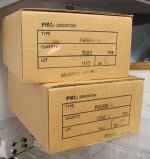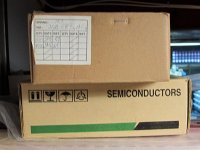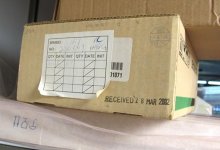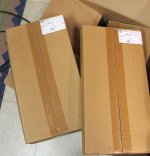These transistors are also pretty much EOL now.
Both the KSC2690 and KSA1220 seem to be active parts from ON Semiconductor (formerly Fairchild).
The reason the 2SD669 and 2SB649 parts keep getting interest is because they are referenced in G. Randy Sloane's excellent books for audio electronics. Unfortunately Randy passed away some years ago so there won't be any updates to his books.
Luckily, you can get boards and kits for most of the best of Randy's projects from Lede Electronics.
They are both on "lifetime buy" status and mostly sold out already at the common distributors (the only authorised distributor who currently has KSA1220 in stock is farnell/element14). Some of the large distributors might stock up on these parts once more, but that is probably it.
Has anyone resorted to using a DPAK-adapter which allows you to mount a little PCB with leads to a real heat sink? Thermal via farm under the package, mounting holes in the right place. Make ‘em with TO-220 and TO-126 basing.
Hell, along those same lines, maybe an MT200 adapter that fits two TO-3P’s and .05 ohm ballast resistors. Solder the packages to the heat spreader, just like Sanken does. I hate this package obsolescence crap. Makes repairing old amps “properly” a lot harder.
Hell, along those same lines, maybe an MT200 adapter that fits two TO-3P’s and .05 ohm ballast resistors. Solder the packages to the heat spreader, just like Sanken does. I hate this package obsolescence crap. Makes repairing old amps “properly” a lot harder.
In a subwoofer amplifier you can put up with a 10X increase in Cob and no one would be the wiser. For low frequency amplification no one cases about THD20k. In some cases, this is not the case and a closer substitute would be required. Especially in VAS duty, not so much with drivers where you can still get a highly linear beta in a bigger device and Cob matters very little.
Has anyone resorted to using a DPAK-adapter which allows you to mount a little PCB with leads to a real heat sink? Thermal via farm under the package, mounting holes in the right place. Make ‘em with TO-220 and TO-126 basing.
Hmm, that ought to be possible with an IMS pcb, you can get surface-mountable header pins. Might have a go at laying this out.
(IMS is PCB with aluminium core - no need for vias)
Yeah, with the backside metalized and a half-decent thermal path good for 10 watts or so. So there isn’t a big thermal gradient between driver and output on a common heat sink. The single vbe multiplier still needs to work. For new designs you could add separate pins with separate diodes, but that’s not a drop-in for your beloved NAD3020.
And of course there needs to be a version on a multilayer board that does the base-emitter crossover. Putting the DPAK on the back messes up the mounting surface.
And of course there needs to be a version on a multilayer board that does the base-emitter crossover. Putting the DPAK on the back messes up the mounting surface.
Just solder wires, not pins, onto the straight pinout perhaps?And of course there needs to be a version on a multilayer board that does the base-emitter crossover. Putting the DPAK on the back messes up the mounting surface.
Apparently these too are obsolete... its a bit scary how quickly discretes are going away... what other subs are there?Both the KSC2690 and KSA1220 seem to be active parts from ON Semiconductor (formerly Fairchild).
The reason the 2SD669 and 2SB649 parts keep getting interest is because they are referenced in G. Randy Sloane's excellent books for audio electronics. Unfortunately Randy passed away some years ago so there won't be any updates to his books.
Luckily, you can get boards and kits for most of the best of Randy's projects from Lede Electronics.
I replaced all 649/669 with 1837/4793 and it works flawlessly in the infinty kappa Subwoofer amp i repaired. Just remember to swap them around.
Also the Sanken sc3263 was blown and the sister (can’t remember the nr) but Tishiba Sc5200n and a1943n took its place
These gone too
I know I'm replying to an old thread but figured it could offer some help... The Toshiba TTA004B and TTC004B might work as a substitute for many TO-126 style drivers. I know the published SOA curve looks awful but, while I can't recommend exceeding the datasheet ratings, I did test a TTA004B with an Aavid 507222 attached for well over an hour with Vce 90V and Ic 40mA. The thermal camera showed a case temp of 85C and the device seemed fine. The HFE measured 198 at Vce 3V Ic 1mA before and after.
Speaking of the published SOA curve for these, there's no way that the 2nd breakdown part of the Ta=25C can be correct that I can work out. It says to derate linearly with increasing temperature, this is also in conflict with Toshiba's own application notes which show epitaxial devices needing to be derated to 0 at 175C in forward bias second breakdown. The data at 100V shows about 15mA at Tc=25C and 3.5mA at Ta=25C. If it's derated linearly, 87.5C would be 1/2 of these values. In other words, if the case is 87.5C from a heatsink being warmed from other devices, they're good for 0.75W. The data also shows 1.5W at Ta 25C without a heatsink, so then the same 0.75W would warm the device to about 87.5C without a heatsink so how could that Ta 25C curve possibly be correct?!
Yes, my test sample size of 1 is certainly not enough to make any kind of judgement from, but the fact that was many times the data limit leads me to believe there's a mistake in the published SOA data. Here's a link to the maximum ratings application note:
https://toshiba.semicon-storage.com/info/docget.jsp?did=63509&prodName=TTA004B
Look at pages 19-21.
-Sol Samet
Speaking of the published SOA curve for these, there's no way that the 2nd breakdown part of the Ta=25C can be correct that I can work out. It says to derate linearly with increasing temperature, this is also in conflict with Toshiba's own application notes which show epitaxial devices needing to be derated to 0 at 175C in forward bias second breakdown. The data at 100V shows about 15mA at Tc=25C and 3.5mA at Ta=25C. If it's derated linearly, 87.5C would be 1/2 of these values. In other words, if the case is 87.5C from a heatsink being warmed from other devices, they're good for 0.75W. The data also shows 1.5W at Ta 25C without a heatsink, so then the same 0.75W would warm the device to about 87.5C without a heatsink so how could that Ta 25C curve possibly be correct?!
Yes, my test sample size of 1 is certainly not enough to make any kind of judgement from, but the fact that was many times the data limit leads me to believe there's a mistake in the published SOA data. Here's a link to the maximum ratings application note:
https://toshiba.semicon-storage.com/info/docget.jsp?did=63509&prodName=TTA004B
Look at pages 19-21.
-Sol Samet
This piqued my interest:
2SB649AL - T60 - T
2SD669AL - T60 - T
https://www.profusionplc.com/parts/2sb649al-t60-t
https://www.profusionplc.com/parts/2sd669al-t60-t
2SB649AL - T60 - T
2SD669AL - T60 - T
https://www.profusionplc.com/parts/2sb649al-t60-t
https://www.profusionplc.com/parts/2sd669al-t60-t
- Home
- Design & Build
- Parts
- Equiv. Parts: 2SD669, 2SB649



